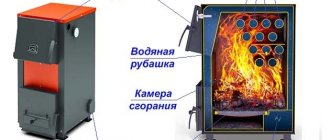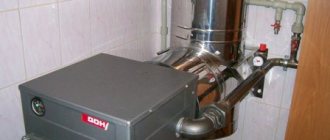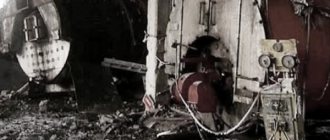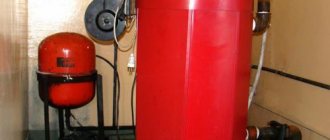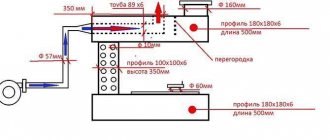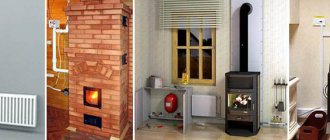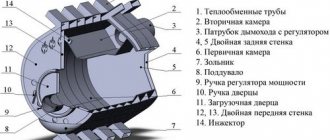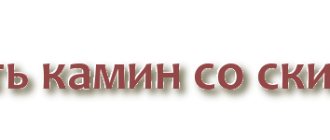Rating of the TOP 10 best solid fuel boilers with a water circuit
| Place | Name | Price |
| TOP 5 best solid fuel boilers with a water circuit | ||
| 1 | Stropuva S30 30 kW | Find out the price |
| 2 | Teplodar Cooper Praktik 8 | Find out the price |
| 3 | Kentatsu ELEGANT-03 17 kW | Find out the price |
| 4 | Stropuva Mini S8 8 kW | Find out the price |
| 5 | Teplodar Cooper Expert-15 | Find out the price |
| TOP 5 best solid fuel boilers with a water circuit and electric heater | ||
| 1 | Teplodar Kupper Praktik 14 14 kW | Find out the price |
| 2 | Teplodar Cooper Expert-22 | Find out the price |
| 3 | Teplodar Cooper Praktik 20 | Find out the price |
| 4 | EVAN WARMOS TT-18K 18 kW | Find out the price |
| 5 | Teplodar Cooper Expert-45 | Find out the price |
How to choose and what to pay attention to?
Experts recommend paying attention to the following points:
- Operating principle and number of circuits . If you need to provide DHW, then you should choose dual-circuit options. If there is a need to maintain heat for a long time without refueling, then long-burning boilers are the best option.
- Fuel type – not all boilers are universal, and the price of fuel varies greatly. It all depends on the preferences and capabilities of the consumer.
- Power . Correctly selected power will ensure a comfortable temperature throughout the entire room; if it is insufficient, the temperature readings will be noticeably lower than expected.
The best solid fuel boilers with a water circuit
Stropuva S30 30 kW
A very powerful boiler unit, operating on wood briquettes and firewood, is capable of heating an area of up to 300 sq.m., which makes it optimal for use not only in private homes, but also in enterprises and agricultural premises.
Due to the design features, fuel combustion is carried out like a candle from top to bottom, which increases the combustion time of the fuel and, consequently, the operating time of the boiler on one filling - up to 31 hours.
To maintain the unit, it is necessary to regularly clean the ash pan and chimney . The optimal shape of the housing saves space in the boiler room during installation.
The spacious firebox can accommodate up to 80 kg of fuel. During operation, the steel body does not heat up, which eliminates the possibility of burns.
Specifications:
- Circuits: single-circuit;
- Energy independence: yes;
- Combustion chamber: open;
- Efficiency: 85%;
- Placement: floor;
- Fuel type: firewood, wood briquettes.
pros
- long-term work on one tab;
- uniform heating;
- economical fuel consumption;
- large heating area.
Minuses
- high price;
- heavy.
Teplodar Cooper Praktik 8
A classic type boiler that supports coal, wood and peat briquettes as fuel.
The built-in thermometer provides the necessary temperature control. The power of the boiler unit is low and is optimal for heating an area of up to 80 sq.m.
Made from quality materials in compliance with quality and safety standards.
The steel body retains heat for a long time, but heats up during operation, so care should be taken in operation.
Also demanding in terms of placement, space between the body and the nearest walls is required.
It is possible to install a thermostat, which is not included in the kit.
Specifications:
- Circuits: single-circuit;
- Energy independence: yes;
- Combustion chamber: open;
- Efficiency: 85%;
- Placement: floor;
- Fuel type: firewood, coal, peat briquettes.
pros
- low price;
- uniform heat distribution;
- small dimensions and weight.
Minuses
- the power is not enough to heat two-story buildings;
- The case gets very hot.
Kentatsu ELEGANT-03 17 kW
Single-circuit boiler unit equipped with a cast iron heat exchanger with an increased surface area, which is achieved by additional fins.
This design increases the overall efficiency of the unit. Heats the coolant to 90 degrees and maintains pressure in the system up to 4 atm.
Capable of heating an area of up to 170 square meters, but the optimum ranges from 120-140 square meters.
Thanks to its design features, it ensures uniform heating throughout the heating system.
The grates are durable and water-cooled.
The front panel supports a mechanical thermostat and thermometer.
Specifications:
- Type: classic;
- Circuits: single-circuit;
- Energy independence: yes;
- Combustion chamber: open;
- Efficiency: 90%;
- Placement: floor;
- Fuel type: wood, coal;
- Circulation pump/expansion tank: no/no.
pros
- quality and reliability of grate bars;
- performance;
- presence of a thermostat and thermometer.
Minuses
- high price;
- heavy.
Stropuva Mini S8 8 kW
Solid fuel boiler unit of low power, which is enough to heat a room with an area of no more than 80 sq.m..
Ideal for a cottage or country house, not dependent on an uninterrupted power source.
Consumes firewood and wood briquettes as fuel, economical due to low fuel consumption.
A full load lasts up to 20 hours of uninterrupted temperature maintenance.
Supplied assembled, making it easy to install and connect . It has small dimensions and a bright design.
However, due to the dense walls, it is quite heavy, weighing 145 kg, so additional assistance may be required during installation.
Specifications:
- Type: long burning;
- Circuits: single-circuit;
- Energy independence: yes;
- Combustion chamber: open;
- Efficiency: 85%;
- Placement: floor;
- Fuel type: firewood, wood briquettes.
pros
- economical in terms of fuel consumption;
- retains heat for a long time;
- small sizes;
- bright design.
Minuses
- the fuel window is located low;
- heavy.
Teplodar Cooper Expert-15
A small but powerful long-burning atmospheric boiler . Capable of heating an area of up to 150 sq.m., but higher rates are maintained on an area of up to 100 square meters.
Thanks to the design features, it is possible to connect a pellet or gas burner.
Volatile option, operating from a single-phase or three-phase network . There is a pre-installed heating element to maintain temperature indicators.
Maintains coolant temperature within 50-95 degrees.
The operating pressure in the heating circuit is 3 bar . There is no control; a thermometer and a pressure gauge are provided to monitor the condition.
Specifications:
- Circuits: single-circuit;
- Combustion chamber: open;
- Efficiency: 85%;
- Placement: floor;
- Mains voltage: single-phase/three-phase;
- Fuel type: wood, coal.
pros
- built-in thermometer and pressure gauge;
- long service life;
- power;
- reliability.
Minuses
- dependence on electricity;
- The burner is not included in the package.
Disadvantages of solid fuel boilers
This type of heating equipment has significant differences from other types of boilers. The main one is the need for a full-fledged chimney , the design of which is complex. Simple pipes that discharge combustion products of natural gas or diesel fuel are not suitable in this case.
Another specific feature of solid fuel boilers is their large mass ; such a boiler cannot be hung on the wall - it needs its own room. The area of the room with heating equipment should be large, since it is worth storing a supply of fuel for several days here. Firewood or coal must be dry, and they have to be loaded manually, and this is another disadvantage of this type of heating equipment.
During the combustion of fuel, ash is formed and must be removed regularly. This disadvantage is also an advantage of boilers, because the property owner has at his disposal valuable fertilizer for growing environmentally friendly food.
The disadvantages of solid fuel boilers are associated with simplicity of design , which ensures a high level of reliability of thermal equipment. Manufacturers of climate control equipment today offer long-burning models, the maintenance frequency of which can reach 24-36 hours. This technique is more expensive, but it minimizes the main disadvantages of boilers. In the absence of plans for gasification of a cottage village, the choice in favor of a solid fuel boiler is obvious, since using electricity for the heating system of a house is not profitable.
The best solid fuel boilers with a water circuit and an electric heater
Teplodar Kupper Praktik 14 14 kW
One of the simplest and at the same time powerful models with an ideal price-quality ratio.
The greatest efficiency is achieved when heating a room of 80-100 sq.m., but it is also capable of heating an area of up to 140 square meters.
The fuel used is firewood, wood briquettes and coal . Fuel consumption is low, so the model is economical to operate.
Optimal for houses with forced water circulation in the system.
A pre-installed heating element allows you to maintain the required temperature for a long time.
The deep firebox ensures that the fuel burns for a longer period of time, and the large ash pan reduces the required amount of cleaning and, therefore, simplifies the maintenance of the boiler unit.
Specifications:
- Type: classic;
- Circuits: single-circuit;
- Energy independence: yes;
- Combustion chamber: open;
- Efficiency: 90%;
- Placement: floor;
- Fuel type: firewood, coal, peat briquettes.
pros
- low price;
- reliable design and high-quality assembly;
- spacious firebox;
- volumetric ash pan;
- small size and weight.
Minuses
- fuel burns out quickly enough;
- thin body walls.
Teplodar Cooper Expert-22
A powerful universal-purpose unit that runs on wood and coal . Capable of heating a room with a total area of up to 120 sq.m.
Top loading and an inclined volumetric firebox add ergonomics, and overheating protection is provided by a stainless steel tray.
Developed heat exchanger and top combustion increase operating time on one fuel load.
It works in four modes - fast warm-up, classic, medium and maximum.
The maximum mode ensures 24 hours of boiler operation.
However, the device does not have automatic fuel ignition, which is not very convenient for a large firebox.
Specifications:
- Circuits: single-circuit;
- Combustion chamber: open;
- Efficiency: 75%;
- Placement: floor;
- Voltage: single-phase/three-phase;
- Heat exchanger: steel;
- Fuel type: wood, coal.
pros
- fast heating;
- duration of work on one load;
- two hatches for cleaning.
Minuses
- no automatic fuel loading;
- no auto ignition.
Teplodar Cooper Praktik 20
A universal boiler unit that can be integrated with other types of boilers . It is possible to connect to a system with natural or forced circulation of coolant, the latter is achieved by connecting an expansion tank and a circulation pump.
Powerful enough to heat a room up to 200 square meters.
It is relatively small in size and weight.
The inclined firebox is convenient for loading fuel . The built-in heating element with a power of 6 kW is removable and can be replaced with a more powerful option.
The cast iron grate is durable, but somewhat fragile due to the characteristics of the alloy . The ash pan is spacious, which reduces the need for frequent emptying.
Specifications:
- Circuits: single-circuit;
- Combustion chamber: open;
- Efficiency: 85%;
- Placement: floor;
- Control: mechanical;
- Heat exchanger: steel;
- Fuel type: firewood, coal, peat briquettes.
pros
- small sizes;
- possibility of upgrade;
- built-in thermometer.
Minuses
- demanding on water pressure in the circuit;
- There are no components for connecting to the chimney.
EVAN WARMOS TT-18K 18 kW
The optimal boiler for residential and industrial premises, can be used as the main or additional equipment for heating a room with an area of up to 120 sq.m..
Demanding on the ventilation system, despite the effective combustion system of the resulting gases and the draft control system.
The built-in heating element prevents defrosting of the heating system.
The work process is carried out on the basis of natural circulation of water due to the difference in temperatures.
If it is not possible to independently pass the coolant through the pipes, additional equipment is required in the form of an expansion tank and a circulation pump.
Specifications:
- Circuits: single-circuit;
- Combustion chamber: open;
- Efficiency: 85%;
- Placement: floor;
- Control: mechanical;
- Heat exchanger: steel;
- Fuel type: wood, coal, peat.
pros
- ease of installation;
- undemanding to fuel;
- high-quality assembly.
Minuses
- demanding on ventilation;
- fuel burns quickly.
Teplodar Cooper Expert-45
One of the most powerful units in the Expert line is intended for industrial and agricultural premises with an area of up to 450 sq.m..
The stainless steel heat exchanger is durable and reliable, and the pre-installed heating element with a power of up to 9 kW maintains the required temperature for a long time.
The dimensions and weight of the boiler are large, but this is due to the power and volumetric firebox, as well as thick walls that prevent them from burning out.
There are connectors for modifying the device with pellet or gas burners. Optimal for the Russian climate and harsh winters of the northern regions.
Specifications:
- Circuits: single-circuit;
- Combustion chamber: open;
- Efficiency: 85%;
- Placement: floor;
- Mains voltage: single-phase/three-phase;
- Fuel type: wood, coal.
pros
- heat exchanger reliability;
- long service life;
- power indicators;
- possibility of modification.
Minuses
- dependent on an uninterrupted source of electricity;
- uneconomical.
Long-burning domestic solid fuel boilers
The most advanced design today are the boilers of the new Suvorov Ultra series. In terms of their characteristics, they have significantly surpassed boilers of earlier series; in some characteristics they have no analogues and therefore will find their consumers who prefer boilers with extremely high technical and operational characteristics.
The design of the Suvorov Ultra boilers, as well as the Suvorov Eco and Suvorov-M boilers, uses high-precision control systems for the volume of air entering the boiler and flue gas temperature control.
At the same time, a number of new technical solutions have been introduced into the design of the Suvorov Ultra series boilers, which make it possible to significantly improve their technical and operational characteristics, as well as implement unparalleled functions. These solutions include:
- implementation of the principle of bottom combustion, in which combustion occurs not of the entire volume of fuel located in the bunker, but of a relatively small volume of fuel in the lower part of the bunker. Which allows for more optimal and, therefore, economical combustion of fuel over a long period of time;
- organizing a distributed supply of heated air, which ensures more uniform combustion of fuel in the required volume of the base of the bunker and the formation of a sufficiently voluminous combustion core;
- increasing the length of the gas path. It is made of three reversals with variable length and is specially configured. This provides adjustment over a wide range of heat removal from the gas flow to the coolant;
- thermal insulation of a part of the gas path in a high-temperature zone and afterburning in it (using heated secondary air) of pyrolysis gases, as well as volatile fuel components in the liquid and solid phase. Due to this, the temperature in the ascending channel can increase to 1200 0C. Highly efficient combustion of fuel components in liquid and solid phases at above-average power significantly reduces the growth of deposits on heat exchange surfaces, which increases the period between boiler cleanings. In addition, it is possible to self-clean the heat exchange surfaces from tarry deposits after operating the boiler at close to minimum power by switching the boiler to nominal or maximum power mode. In another part of the gas path there is a turbulator, which provides an additional increase in heat removal from the gas flow of flue gases;
- lining the base of the bunker and the gas path with fireclay slabs, which ensures an increase in the volume of the hot core of the burning fuel, a decrease in the volume of relatively cold peripheral zones, an increase in the temperature in the furnace (up to 900 - 1000 0C) and more complete combustion of the components contained in the fuel;
- changing the ratio of primary and secondary air when the boiler operates at different capacities, which ensures a reduction in heat losses and an additional increase in its efficiency;
- installation of a large-area smoke exhaust damper with a loading door locking system, which ensures more convenient and safe operation of the boiler when reloading fuel;
- expanding the types of fuel used. In addition to firewood, sawdust and peat briquettes, sawdust, coal and pellets can be used.
A set of new technical solutions made it possible to implement a fundamentally new functionality in a solid fuel boiler - operation of the boiler in standby modes and extremely low power modes with automatic transition to and exit from this mode. The boiler goes into standby mode automatically in the event of an emergency (stopping the operation of the circulation pumps), or is manually transferred by turning them off and can remain in it for a long time, generating a small power (hundreds of watts) equal to the heat losses of the boiler through its body and due to small circulation of coolant in the heating system (mainly through the hydraulic arrow). When the circulation pumps resume operation or heat energy is taken from the hot water supply circuit, the boiler automatically switches to the power consumption generation mode. The boiler can implement a mode for generating ultra-low power and electronically adjusting thermal power over a wide range, which can be used in the summer to produce hot water or to maintain the required temperature in the house during cold periods or autumn-spring periods. The specified functionality increases the reliability of the heating system and the safety of operation of the boiler, and also expands its operational characteristics.
In general, increasing the volume of fuel loaded into the boiler and its highly efficient combustion make it possible to ensure a longer combustion duration from one load of fuel, both at maximum and minimum power. In particular, with sawdust briquettes, the boiler operating time is up to 28 hours at rated power and up to 126 hours at minimum, when using firewood, up to 10 and 69 hours, respectively, which is significantly longer than its analogues. At the same time, using wood, a fuel utilization rate of 95.7% was obtained (the percentage of recoverable thermal energy contained in the fuel). In ultra-low power mode, the operating time of the boiler can increase several times. The long duration of operation of the boiler in automatic mode, including in standby mode, significantly simplifies the maintenance of the boiler during its operation.
Thus, the developed series of boilers of the Suvorov brand have high technical and operational characteristics that are not inferior to well-known analogues, and in some respects surpass them.
Types of solid fuel boilers with a water circuit
Boilers with a water circuit are divided into traditional, long-burning, universal and pyrolysis - depending on the type of combustion.
- Universal - operate on any fuel with the ability to connect a gas burner. They are equipped with a high-quality safety system that prevents fire or work stoppage without operator control.
- Long-burning - they work on the principle of a candle, which ensures uninterrupted heating from a day to a week. However, due to the design features they are quite expensive.
- Pyrolysis - with two fuel chambers that consume fuel and the gas generated during its combustion. They have very high efficiency and produce less thermal pollution.
- Traditional ones are similar in principle to a conventional oven, do not require electricity, are accessible and relatively cheap.
Types of devices
Solid fuel boilers are classified according to fuel combustion processes:
- Traditional boilers with water circuit. This is a non-volatile class of equipment. In them, the combustion process proceeds from the bottom up, the fuel is loaded manually. It burns in a fixed layer on a grate, air enters the firebox naturally through the holes, and the burned gases are released into the atmosphere due to the vacuum created by the height of the chimney. Combustion at one fuel filling lasts from 2 to 6 hours, depending on the combustion volume, type of fuel and its calorie content.
- Long burning. A distinctive feature of such units is the top loading of fuel. Combustion occurs at the bottom of the fuel on the grate; as it burns out, the fuel is released, which ensures a continuous combustion process on one tab during the day.
- Pyrolysis water boilers. The most promising and expensive boilers are equipped with two combustion chambers. In the first, fuel smoldering and the formation of pyrolysis gas occurs, and in the second, the afterburning principle is implemented, where highly efficient pyrolysis gas burns, releasing a significant amount of thermal energy. These boilers have the highest efficiency and cost. They also require storage facilities for storing fuel, which must be taken into account before connecting the boiler.
- A universal water heating boiler - capable of operating on different types of fuel from electric to gas, after appropriate replacement of the burner device. However, they achieve the calculated efficiency only when using the main type of fuel. On other types it will be significantly lower with a drop of up to 10%. This is due to the fact that the smoke ventilation system is designed for solid fuel and the corresponding speed of movement of flue gases, as well as the possibility of heat removal from the “water jacket” of the boiler.
Advantages and disadvantages of solid fuel boilers with a water circuit
The advantages of boilers with a water circuit are high quality assembly, long service life, economical fuel consumption and low requirements for regular technical inspection.
Some models have high efficiency due to the recycling of combustion products. Most boilers do not require installation.
However, most of these boilers have lower efficiency compared to other types of boilers.
They also need to be regularly loaded with fuel - on average, every 5-6 hours, with the exception of long-burning options and models with automatic supply of wood or coal.
Integrating the stove into a water heating system
It is possible to integrate a furnace with a water circuit into an existing water-type heating system. If the house has, for example, a gas boiler, then you can connect a stove to it, which will replace the heating boiler.
Modern heating devices, as a rule, do not have tanks for heating water. However, they have a heat exchanger that is used for the same purpose.
Today, the market offers a large range of stoves with a built-in heat exchanger, which are capable of not only heating the room, but also providing the entire house with hot water.
Modern models of stoves involve the use of not only ordinary firewood as fuel, but also pellets - wood granules made in industrial conditions.
Water circuit - what is it and why is it needed?
The water circuit is a well-known heating system using radiators . It is necessary in houses with a not very good layout, it reduces heat loss from the window, and evenly heats the room.
Traditional boilers without a water circuit heat locally, and if there are more than two rooms in the house that are not in contact with the boiler room, a water circuit is simply necessary, because in its absence, remote rooms will not warm up sufficiently.
Heat loss in them will be very high, and temperatures often do not even reach optimal for living and long-term stay.
In addition, in houses with stove heating, corners often freeze . A water circuit will avoid this problem.
Wood-burning boiler with water circuit
Monitoring and control systems
Solid fuel heating boilers for private homes are equipped with systems for regulating the water temperature in the water circuit.
A fairly simple thermostat is connected to a lever to which a metal chain is attached. The second end of this chain is attached to the blower flap. When the optimal temperature is reached, the thermostat turns the lever and closes the damper. The air flow is reduced and the combustion process is suppressed until the water cools down to the control system's return temperature. Mechanical air supply control is primitive, but reliable. Remote Control
More sophisticated control systems include electrified forced air supply and more accurate temperature sensors. A low-power electric fan (up to 35 W) built into the air duct system can supply increased air flow not only from below.
The air supply from above creates an artificial “active smoldering” effect in the flame, which allows fuel to be burned much more thoroughly. Such boilers require connection to power supply systems and, in the absence of electricity, become more helpless than their mechanical “brothers”. But fuel savings of 10-15% allow us to say that such systems justify the installation of forced ventilation.
The boiler is not only an independent unit, but also part of the heating system of a private home. Therefore, the power of the equipment must correspond to the volume and circulation pattern of the coolant in the system. If the system is built taking into account forced circulation of water and the rate of heating of the premises is controlled together with the process of fuel combustion in the boiler, the efficiency of the system increases. A thermos tank will help maintain a high water temperature when the boiler goes out.
The base for the equipment must be made of concrete; a sheet of metal with an area of at least 1 sq.m. must be laid on the floor under the ash chamber. The distance to the walls of the room should be at least 30 cm, especially if they are wooden. It is best to make an isolated room in the basement or first floor of the house (mini-boiler room) with a supply of firewood.
Causes of failures during system operation
During the operation of a homemade boiler, certain difficulties may arise. This is not necessarily due to errors made during installation work. The most common problems are:
- Condensate is leaking from the unit. The reason is the low return temperature. To eliminate this, you will need to ensure that the temperature does not drop below 60 degrees.
- The boiler is overheating. The reasons for this are varied:
- generation of excess heat - occurs when the device regenerates additional energy over a small area, water boils, and unnecessary heat escapes through the safety valve;
- stopping the circulation pump: when the pump is de-energized, the cyclicity of the heat supply is stopped. The system boils, releasing excess heat through the protection valve.
Reference. To protect the device with a heating circuit from overheating, you will need to purchase a storage tank and an uninterruptible power supply.
- Smoke leaks through the doors. The chimney must be cleaned.
- Water is leaking from the chimney opening. You'll have to insulate the hood.
- Excessive fuel consumption. The room is poorly insulated, low efficiency of combustible materials.
Review of manufacturers
The complexity of making a wood-burning boiler yourself should not be exaggerated. But still, in general, samples assembled at factories under the guidance of experienced engineers prove to be more reliable and stable. It is, of course, impossible to disassemble all the models that appear in the ratings of the best heating equipment.
But it is extremely important to read reviews about the relatively cheap and most popular versions of boilers
NMK "Sibir-Gefest KVO 20 TE" is designed to supply hot water only to the heating circuit and is capable of generating 20 kW of thermal energy per hour. The equipment of this model is completely independent of electricity, because it is controlled by a mechanical system. Using an open combustion chamber with an efficiency of 80%, it is possible to heat up to 200 m2. In addition to the wood firebox, a 4000 W heating element is provided.
Another very attractive version is the Kiturami KF-35A double-circuit boiler. This device is also equipped with an open firebox and provides power up to 24 kW. Its efficiency is 5% higher than that of Sibir. The connecting dimensions of the chimney are the same. The Korean manufacturer provides an official guarantee of 24 months. The load can contain up to 40 kg of wood, the burning time reaches 5-6 hours. It is allowed to lay firewood up to 0.85 m long.
Features of operation of such boilers
- low price (every homeowner can afford it)
- long service life
- reliability (if used correctly there is simply nothing to break)
- availability and low cost of fuel
- do-it-yourself setup and maintenance (does not require high qualifications)
- relatively low efficiency (compared to gas or diesel boilers)
- periodic loading of firewood is required (once every 3-8 hours)
As you can see, such boilers have both their pros and cons. However, the fact that they are ubiquitous in our country suggests that the use of such equipment for heating a house in winter is very effective.
Boiler design
- So, any boiler you can buy consists of:
- combustion chamber
- grate
- chambers for collecting combustion products (ash chamber)
- heat exchanger (water circuit)
The combustion chamber is the heart of a wood-burning boiler, or fireplace. Wood combustion occurs in it and heat is released. Volatile combustion products enter the combustion chamber into the chimney, which leads them outside. The air required for combustion enters the combustion chamber through the lower ash pan (ash pan), or through adjustable blinds in the combustion door. The combustion chamber is also equipped with a door for loading fuel. It can be made both from the materials of the boiler body and from glass, such as, for example, near a fireplace.
At the bottom of the combustion chamber there is a grate. Through it, the coals and ash remaining from the combustion of wood enter the chamber for collecting solid combustion products.
The ash chamber is equipped with a door, which is used to clean it from unburned residues and to regulate the intensity of combustion by increasing or decreasing the flow of fresh air into the lower part of the combustion chamber. You can do this with your own hands or with the help of a special mechanical thermostat that regulates the flow of fresh air into the combustion chamber depending on the achievement of the specified fluid temperature in the water circuit.
The heat exchanger can be a water circuit, which is like a second body of the combustion chamber. In this embodiment, the liquid heated by the boiler circulates around the firebox, isolating it from the outer casing of the wood-burning heating boiler. Such a heat exchanger is very effective in terms of quickly warming up the liquid and reducing unnecessary heat losses, but if it is damaged for any reason, repairing this circuit can be very difficult.
Also, a system of pipes passing through the internal space of the boiler in the places of the most efficient heat transfer from the combustion chamber can be used as a heat exchanger. Such a system is more convenient to repair than a continuous water jacket system, because each pipe, or the entire pipe system, can be easily pulled out and replaced with a serviceable one.
Boiler interior
The combustion chamber, a system of heat exchangers, is insulated from the outer casing with non-combustible materials with a low thermal conductivity coefficient. This could be asbestos, mineral wool, fireclay clay, ceramic filler, etc. materials.
Such thermal insulation has two goals: - firstly, by reducing the heat transfer of the boiler body into the surrounding space, the efficiency of the boiler itself significantly increases, in terms of the efficiency of heating the working fluid; - secondly, the operating safety of the boiler itself increases when it is installed in a room with fire-prone building materials.
Some nuances in the operation of double-circuit solid fuel boilers
An obvious advantage that solid fuel boilers of this type have is long-term operation with a single fuel load.
For example: 30-50 kg. Firewood placed in the firebox can burn for up to 12 hours. During this time, the unit is able to provide the maximum possible heat to heat living spaces in the house and provide normal domestic needs for hot water. Reducing the consumption of hot water will increase the duration of fuel combustion to 24 hours. The boiler will operate in nominal mode, maintaining a certain temperature in the house.
Something to remember! A solid fuel unit that goes out for a long period during winter can cause the entire heating system to freeze. To avoid such troubles, you can use antifreeze for the main heating circuit.
An important fact is that long-burning double-circuit boilers do not allow high-precision regulation of the temperature of the coolant in the heating system. The reason for the difficulty lies in the inertia of the operating heating equipment. A built-in boiler will solve this problem by creating optimal conditions for controlling the heating unit.
In conclusion, a few words should be said about where and how it is best to install this heating equipment in the house. Heating equipment that runs on solid fuel is available only in a floor-standing version. Due to the bulkiness of the structure itself and the need to install a storage tank, the best option would be to equip a special boiler room.
Tips for use
Like a simple stove, a wood-burning boiler must be operated according to strictly defined rules. Although some manufacturers allow raw wood to be loaded, thoroughly dried wood is still preferable. It increases not only the efficiency of the device, but also its overall service life. During use, you need to carefully monitor the condition of even seemingly minor structural parts. At the very beginning, very small firewood is laid.
Under the firewood they lay out paper, shavings, dried moss or tree bark, then small twigs. You cannot stack firewood very tightly, because if there are no gaps between them, the operating mode of the device will be disrupted. When there are no branches, chips or paper, you can light a wood-burning boiler with pine paws. Ignition with any liquids of natural or industrial origin or gas is strictly prohibited. The pyrolysis chamber is cleared of combustion products before any new kindling.
Noise in the chimney, accompanied by the appearance of a white fire in the firebox, indicates excessive draft intensity. But red tongues appear if the supply of oxygen is unreasonably low. The best and most stable mode is when the wood burns yellow.
In the next video you will find a review of a 12-hour long-burning wood burning boiler.
DIY welding
The materials for making the device are quite affordable, and the tools required for the job are easy to find. The home handyman will need certain skills as a welder and plumber.
You will need:
- Metal container (ordinary barrel, without signs of corrosion). The housing of the unit must be made completely sealed. If there are flaws, they are brewed by filling them with water. The slightest leak is excluded.
Photo 2. Metal barrel, which is suitable for making a wood-burning boiler. Before work, you need to remove the paint from it.
- Thick sheet metal for welding heat exchangers. It is possible to replace homemade radiators with used cast iron batteries. 5-6 sections are enough for the body. Cast iron serves as a good heat conductor, maintaining the required temperature for a long time.
- Profile pipes for the chimney, installation of the frame.
- Doors, gate valves, grates. If the house is large, you will need a circular pump, since the coolant will not rise up through the pipes. There is a reality of defrosting the system during cold periods. Experts advise purchasing a thermometer and a pressure gauge for the mounted device.
- To separate the pipes, you will need to install metal-plastic fittings and cast iron radiators, since solid fuel units with contour heating will not be able to function normally without this.
How to assemble a device using a homemade method
One of the main installation tools will be a welding machine. If you have no work experience, further work is dangerous.
Boiler assembly algorithm:
- Create (at least schematically) a drawing of the future assembly of the boiler and heating circuit.
- Assemble the base that will support the unit. Profile pipes or metal corners are used. It is proposed to design the upper part of the apparatus in an arched shape, which will allow the barrel to take a more stable position.
- Prepare the barrel. Make holes for the combustion chamber and ash, for the chimney, as well as the inlet and outlet openings.
- The tank is installed at the back of the firebox. One of the features of wood-burning boilers is that the exhaust gases envelop the unit, helping to heat the heat exchanger. The installation of the device is done strictly vertically, the fittings are first brought to the holes made.
- They install a metal chimney pipe and prepare the lid and door. The chimney is led out into a common ventilation hole. If there is no ventilation, the pipe is led to the roof.
Next, it is recommended to test the homemade circuit unit. You will need some fuel, which is placed in the combustion chamber and set on fire. If there is no leakage of exhaust gases, proceed to install pipe distribution in all rooms.
Adviсe:
- during installation, carefully consider the correct choice of circuit: the presence of one pipe creates uneven heating, two pipes - makes it possible to regulate the temperature when installing Mayevsky taps at the ends of the radiators;
- connect the fittings and batteries in series;
- Place the expansion tank on the supply line.
After diagnostics, we inspect the structure, eliminate deficiencies, and start the heating process.
Possible difficulties during assembly
It is important to know that a homemade solid fuel device belongs to a risk zone and is included in the group of high-risk structures. Possible problems with incorrect assembly:
A mismatch in the diameter of the chimney pipe leads to poor draft and a decrease in the temperature in the system. Boiler doors are most often not airtight, due to which there is a possibility of smoke leaking into the combustion chamber and there is a risk of carbon monoxide poisoning. Installation of the device without safety devices. This refers to the explosion valve for releasing air and the expansion tank. Formation of condensation in the chimney due to improper assembly of the system
With a horizontal section of the chimney, it is important to install a revision (special cover), which must be regularly cleaned of soot in order to protect the room from fire
Advantages and disadvantages of long-burning solid fuel boilers
Before you begin to study the design of a solid fuel boiler used for heating a private home, you need to familiarize yourself with the advantages and disadvantages inherent in this type of heating equipment.
The advantages of long-burning boilers operating on solid fuel are:
- environmental Safety;
- high heat transfer rates, amounting to up to 90% of the generated thermal energy;
- ease of installation and maintenance;
- the possibility of using different types of solid fuel and its relatively low cost;
- versatility - can be used for heating and hot water supply;
- compactness;
- long combustion periods that do not require frequent loading of burned fuel;
- the ability to operate in automatic mode without the constant presence of maintenance personnel.
Solid fuel boilers operate on different types of fuel - wood and coal, wood pellets and peat briquettes
The disadvantages include the following:
- fuel used in long-burning boilers must meet the requirements for it (humidity, quality, etc.);
- Safety precautions when using solid fuel boilers must be observed at all stages of the work performed: storage and preparation of fuel, combustion and waste disposal;
- the complexity of loading fuel if the boilers are not equipped with automatic systems for this process;
- the cost of boilers of this group is slightly higher than that of short-burning analogues;
- for boilers equipped with an automation system - dependence on the availability of electricity supply and the need for large premises used for fuel storage.
Solid fuel boilers vary in design, technical characteristics and sizes
Smolder and heat: features of using long-burning wood-fired boilers for the home. In a special publication on our portal we will talk in detail about long-burning wood-burning boilers. You will learn the types of boilers and operating principles, the basic requirements for a heating system with a wood-burning boiler, and become familiar with calculating the power of a wood-burning boiler.
How to choose the power of a solid fuel boiler with a water circuit
The choice of power for a boiler with a water circuit is practically no different from a conventional one . The simplest calculation is to divide the heating power by the specific power of the boiler unit.
The result obtained is reduced by 10 times . The result is the starting point in selecting the power of a boiler with a water circuit.
In cold regions, it is worth adding 20% to the number to take into account heat loss and climatic features.
The most popular formula is V*T*K/850.
V is the volume of the room, T is the difference between the optimal temperature in the room and the minimum temperature outside.
K – heat loss coefficient, depending on the room. For modern structures with double-glazed windows it is 0.5, for wooden buildings - 4.
Which manufacturer is better?
Solid fuel boilers with a water circuit are supplied by Russian and foreign manufacturers.
Experts highlight the following brands, whose equipment is most optimal for Russian climatic realities:
- Teplodar is a Russian brand that has been operating since 1997 and has its own unique patented technologies. The brand annually renews its technology park, using high-quality machines from world brands to produce heating equipment.
- Zota is a relatively young brand that takes into account the climatic conditions of the countries where heating equipment is supplied. They also take into account the features of regular maintenance, which is not always possible due to the remoteness of residential areas from large cities and service centers. They supply a large number of different modification components.
- Stropuva is a Lithuanian company founded in 2000. They own a patent for candle-type fuel combustion technology. Thanks to this technology, long-burning boilers were developed. Product production in Russia is carried out in a joint venture; thanks to the experience of domestic specialists, the brand develops boilers optimized for the realities of the Russian climate.
Rating updated September 12, 2021.
